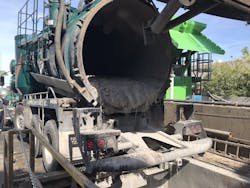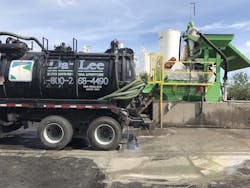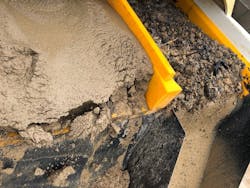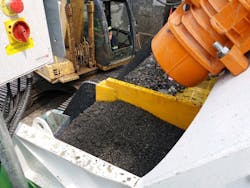About the author:
Ryan O’Loan is business development manager for CDEnviro. O’Loan can be reached at [email protected] or 810.360.8312.
Sometimes basic ingredients can appear unpromising, yet when mixed together the end result is satisfactory, just like a cake. However, not everything is greater than the sum of its parts and in some cases getting “back to basics” brings its own rewards.
Take hydro excavation (hydrovac) for instance, which uses pressurized water to move or remove soil and heavy debris from construction and infrastructure sites. It is popular as it is a reliable and accurate process. However, the output of slurry, usually made up of around 60% wastewater and 40% solids, is not the most appealing mixture. Its exact constitution is also highly unpredictable, making planning ahead difficult.
Dealing with this byproduct can cause several problems for hydrovac operators. It is difficult and expensive to dispose of, especially if landfill is the intended destination. It can be even worse if it is being treated as a liquid.
Whether it is considered as dry or wet waste, hydrovac trucks usually have to travel for a considerable distance to find legal dump sites for disposal. This is time consuming and costly. Adding sawdust or similar material to the waste to solidify it, an option explored by some, only adds to the cost. The commodity itself is usually expensive and the additional weight adds to disposal fees. This approach is therefore inefficient and unsustainable.
An additional issue operators face is legislation, including the U.S. EPA Biosolids Laws and Regulations and increasing environmental expectations. These legal challenges and hurdles are only likely to increase, adding to project costs and complications.
Back to Basics Approach
It is not all bad news though. Rather than a reactive approach to dealing with the slurry, taking control of disposal options is now a possibility. Reducing or eliminating the material that needs dumping by optimizing recycling options instead can produce a much more attractive proposition.
Processing systems are now available which can be set up close to excavation sites, even in urban locations, and offer a great opportunity to reduce transport and disposal costs, and even eliminate legal and environmental risks associated with current disposal methods.
Trucks can deliver the slurry directly into the treatment systems, which sort and clean the material, no matter how varied. The end result is clean, compliant recycled outputs; usually including sand, stone and clay. Even the water can be treated so that it can be reused.
Reducing the excavation byproducts to their basic parts in this way means a potential revenue stream can be developed from the previously unpromising combined material. Operators can not only reduce the costs of dumping, but by extracting and recycling material in the slurry, they have the opportunity to resell some of the outputs, such as recycled sand. Sometimes this can mean selling the sand back to the site from which it was excavated now that it is in a usable state.
Processing the waste on site is viable, practical and cost effective. By dealing with it in-situ, the risk of having to transport potentially toxic substances to waste disposal companies is also reduced. This prevents possible leaks or accidents during transport, which is an important consideration.
This approach removes a lot of risk that waste handlers are exposed to today and also means operators can offload trucks quickly and return promptly to the dig site. This maximizes the efficiency on the project and keeps hydrovac trucks in operation for longer as they are not wasting time traveling to and from dump sites.
Put Into Practice
Da-Lee Environmental Services has adopted this new approach. Based in Stoney-Creek, Ontario, Canada, the company offers a range of waste classification services, including treatment, disposal, transportation and handling of a wide range of hazardous and non-hazardous waste around Southern Ontario from Toronto to the U.S. border. Prior to investing in the new equipment, it had always handled mixed solid and liquid wastes by adding sawdust to solidify the materials so they could be taken by truck to landfill.
The company wanted to see if it could improve this process and reduce overheads, such as the cost of purchasing, storing and handling the required sawdust. Added to this, as the waste being treated was being solidified but not dewatered, the weight of the water was still going to a landfill, which led to further unnecessary expenses.
After installing a new waste processing unit at its Stoney-Creek site in 2018 the company was able to treat not only hydro excavation waste, but also storm drain material, gully waste, culverts, gross pollutant traps, and a range of other materials, in a much more cost efficient way.
The new approach has brought significant savings both in terms of the dollar per ton disposal gate fee and the carbon footprint impact of the entire operation.
The system employs wet processing techniques specifically designed to treat and dewater waste streams, extracting the sand and oversize components in the process, leaving the residual water easier to treat. Recovered sand output products are diverted from landfill and have been reused in low-grade construction applications, including pipe bedding, road fill and landscaping. The remaining dewatered material is easy to dispose of and handle.
Return on Investment
The systems require an upfront capital outlay, but this can be outweighed by the reduced weight, and therefore cost, of the waste going to a landfill, the easing of the logistical burden on the team, time saved on projects, and environmental impact.
Many operators will also offer finance options to make them affordable. There is significant potential for return on investment, with the best systems proven to divert 85% of material from landfill.
The highly-efficient process reduces both disposal and transport costs and the time it takes to complete projects and dispose of waste. With increased efficiency, companies can a gain competitive advantage by accepting more contracts than before and bringing the best value to their customers.
All the Right Ingredients
Treating and recycling the mixed state waste material from hydrovac projects offers many advantages over dumping. It reduces overheads—including landfill costs— and meets or eliminates regulatory requirements, and offers a new sustainable revenue stream. With that many benefits, it really is a case of having your cake and eating it too.



